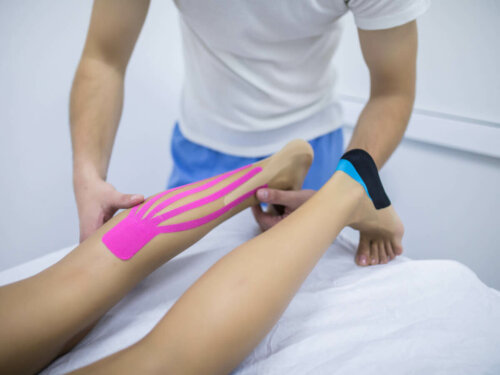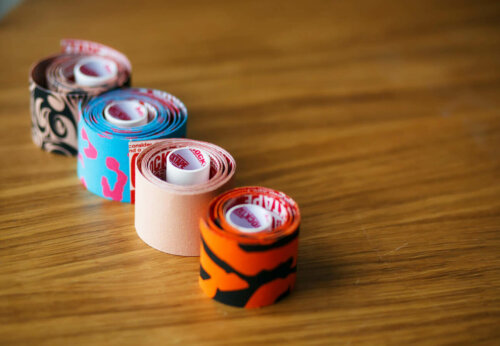Neuromuscular Bandage: What Is It For?

Surely you’ve seen many athletes, and even people around you, with colored strips on their bodies? These strips are a neuromuscular bandage, a technique that’s been gaining popularity in the last two decades. Do you want to know what it is and how it works? We’ll tell you everything you need to know in this article!
Today, people use this bandage in many cases and, as with many techniques, there are times when its uses are exaggerated. Also, it’s often used in situations where it doesn’t provide benefits to the patient. Let’s see what it is and when you should use it.
Neuromuscular bandage: what is it?
The neuromuscular bandage is also known as Kinesio taping or neuromuscular taping. The system is based on applying elastic bandage strips to the patient’s skin.
The theory is that a bandage that remains in place helps the fascia, decompresses the area and stimulates circulation, among other benefits. Everything is due to the force that the bandage exerts, which stretches the skin in a gentle but constant way. In fact, there are different types of bandages – hence the colors – that have greater or lesser traction force.
However, even though it was invented in the 1970s, there aren’t a lot of scientific articles that support its use and demonstrate its benefits. In fact, there are several studies that deny its usefulness, but there are also others that support it.
As always, you should keep in mind that a lack of studies doesn’t show that it isn’t useful. However, applying specific bandages on a specific area of the body and for a certain condition or looking for a certain effect hasn’t shown to be beneficial.
It may be that applying the bandage in another way will have an effect or that there are other benefits that weren’t the subject of the study. Let’s take a look at what the existing literature tells us.

What is a neuromuscular bandage for?
One area in which neuromuscular bandaging has proven effective is in improving the patient’s proprioception. In other words, they help the person who uses it – in this case, at the ankle – to better know what position the joint is in and to be able to adapt to changes.
Let’s say that having the bandage on makes you more aware of that part of the body. If there’s any change or movement, the bandage will pull more, and it’ll be a constant reminder.
Regarding pain, there are also studies that speak well of the short-term neuromuscular bandage. We can say that this type of bandage helps to control pain in muscle conditions immediately after its use and for up to 24 hours.
Its use has also proven helpful in patients with chronic soft tissue pain. Therefore, the bandage also takes some tension off the affected tissue, allowing it to heal.
On the contrary, there’s no evidence on its use to increase the force that the muscles can exert. Studies in this regard are, at best, contradictory. In other words, it’s usefulness hasn’t been confirmed or denied, since there are cases in which it proves to be useful and others in which it doesn’t. Therefore, we should note that there may be other factors that affect this section and which the bandage isn’t capable of improving.
As for muscle endurance, it also has limited effects. In recent research, researchers showed that it does improve, but in a proportion that falls within a possible measurement error.
The various application methods and tensions
With the different types of tension that exist on the market and the different application methods described, it’s difficult to study all the variables. That is, studies, by their nature, have to be limited to analyzing a certain technique on a specific area of the body; they aren’t able to cover a wide range of possibilities because too many variables come into play.

Thus, many of the studies we reviewed end up admitting that they need more studies, both to confirm or to advise against its use.
So … should you use a neuromuscular bandage?
As a result of the above, we can see that the bandage does have effective uses. In principle, there’s no evidence to recommend its use in healthy subjects. In other words, the neuromuscular bandage won’t help people who don’t have problems to exert more force.
However, it can be useful for people who are injured on a recurring basis to improve their proprioception. Therefore, we recommend working on this concept with bandages.
On the other hand, the bandage can also be useful for people who have a basic condition. In these cases, it can help control pain and improve their performance, both in muscles and soft tissues.
In short, this is what neuromuscular bandages are for. Its application as a supplementary technique, together with the appropriate treatment, will help achieve more effective results in the cases we detailed.
Surely you’ve seen many athletes, and even people around you, with colored strips on their bodies? These strips are a neuromuscular bandage, a technique that’s been gaining popularity in the last two decades. Do you want to know what it is and how it works? We’ll tell you everything you need to know in this article!
Today, people use this bandage in many cases and, as with many techniques, there are times when its uses are exaggerated. Also, it’s often used in situations where it doesn’t provide benefits to the patient. Let’s see what it is and when you should use it.
Neuromuscular bandage: what is it?
The neuromuscular bandage is also known as Kinesio taping or neuromuscular taping. The system is based on applying elastic bandage strips to the patient’s skin.
The theory is that a bandage that remains in place helps the fascia, decompresses the area and stimulates circulation, among other benefits. Everything is due to the force that the bandage exerts, which stretches the skin in a gentle but constant way. In fact, there are different types of bandages – hence the colors – that have greater or lesser traction force.
However, even though it was invented in the 1970s, there aren’t a lot of scientific articles that support its use and demonstrate its benefits. In fact, there are several studies that deny its usefulness, but there are also others that support it.
As always, you should keep in mind that a lack of studies doesn’t show that it isn’t useful. However, applying specific bandages on a specific area of the body and for a certain condition or looking for a certain effect hasn’t shown to be beneficial.
It may be that applying the bandage in another way will have an effect or that there are other benefits that weren’t the subject of the study. Let’s take a look at what the existing literature tells us.

What is a neuromuscular bandage for?
One area in which neuromuscular bandaging has proven effective is in improving the patient’s proprioception. In other words, they help the person who uses it – in this case, at the ankle – to better know what position the joint is in and to be able to adapt to changes.
Let’s say that having the bandage on makes you more aware of that part of the body. If there’s any change or movement, the bandage will pull more, and it’ll be a constant reminder.
Regarding pain, there are also studies that speak well of the short-term neuromuscular bandage. We can say that this type of bandage helps to control pain in muscle conditions immediately after its use and for up to 24 hours.
Its use has also proven helpful in patients with chronic soft tissue pain. Therefore, the bandage also takes some tension off the affected tissue, allowing it to heal.
On the contrary, there’s no evidence on its use to increase the force that the muscles can exert. Studies in this regard are, at best, contradictory. In other words, it’s usefulness hasn’t been confirmed or denied, since there are cases in which it proves to be useful and others in which it doesn’t. Therefore, we should note that there may be other factors that affect this section and which the bandage isn’t capable of improving.
As for muscle endurance, it also has limited effects. In recent research, researchers showed that it does improve, but in a proportion that falls within a possible measurement error.
The various application methods and tensions
With the different types of tension that exist on the market and the different application methods described, it’s difficult to study all the variables. That is, studies, by their nature, have to be limited to analyzing a certain technique on a specific area of the body; they aren’t able to cover a wide range of possibilities because too many variables come into play.

Thus, many of the studies we reviewed end up admitting that they need more studies, both to confirm or to advise against its use.
So … should you use a neuromuscular bandage?
As a result of the above, we can see that the bandage does have effective uses. In principle, there’s no evidence to recommend its use in healthy subjects. In other words, the neuromuscular bandage won’t help people who don’t have problems to exert more force.
However, it can be useful for people who are injured on a recurring basis to improve their proprioception. Therefore, we recommend working on this concept with bandages.
On the other hand, the bandage can also be useful for people who have a basic condition. In these cases, it can help control pain and improve their performance, both in muscles and soft tissues.
In short, this is what neuromuscular bandages are for. Its application as a supplementary technique, together with the appropriate treatment, will help achieve more effective results in the cases we detailed.
All cited sources were thoroughly reviewed by our team to ensure their quality, reliability, currency, and validity. The bibliography of this article was considered reliable and of academic or scientific accuracy.
- C. Brogden, K. Richard, M. Page et al. The efficacy of elastic therapeutic tape variations on measures of ankle function and performance. Physical Therapy in Sport. Volume 32, Pages 74-79, 2018.
- R. Taylor, G. Cert, L. O’Brien, et al. A scoping review of the use of elastic therapeutic tape for neck or upper extremity conditions. Journal of Hand Therapy. Volume 27, Issue 3, Pages 235-246, 2014.
- A. Henar, R. Blanco y L. Justo. Efectos del kinesiotape sobre el tono y la fuerza muscular. Revisión. Volumen 5, Número 1, Páginas 151-171, 2019.
This text is provided for informational purposes only and does not replace consultation with a professional. If in doubt, consult your specialist.








